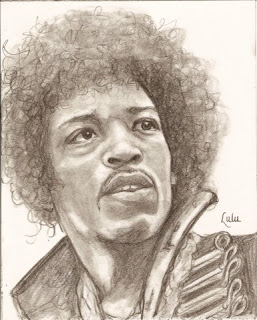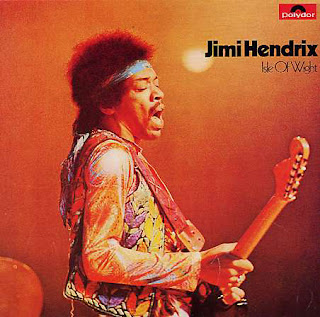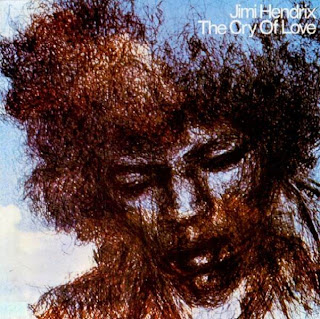JIMI HENDRIX – STORY
 James Marshall Hendrix was born
James Marshall Hendrix was born
 Unquestionably one of music's most influential figures, he brought an unparalleled vision to the art of playing electric guitar. Self-taught (and with the burden of being left-handed with a right-handed guitar) he spent hours absorbing the recorded legacy of southern-blues practitioners, from Robert Johnson
Unquestionably one of music's most influential figures, he brought an unparalleled vision to the art of playing electric guitar. Self-taught (and with the burden of being left-handed with a right-handed guitar) he spent hours absorbing the recorded legacy of southern-blues practitioners, from Robert Johnson
 The aspiring musician joined several local R&B bands while still at school, before enlisting as a paratrooper in the 101st Airborne Division. It was during this period that Hendrix met Billy Cox,
The aspiring musician joined several local R&B bands while still at school, before enlisting as a paratrooper in the 101st Airborne Division. It was during this period that Hendrix met Billy Cox,
 a bass player upon whom he would call at several stages in his career. Together they formed the King Kasuals,
a bass player upon whom he would call at several stages in his career. Together they formed the King Kasuals,
 an in-service attraction later resurrected when both men returned to civilian life. Hendrix was discharged in July 1962 after breaking his right ankle. He began working with various touring revues backing, among others, The Impressions,
an in-service attraction later resurrected when both men returned to civilian life. Hendrix was discharged in July 1962 after breaking his right ankle. He began working with various touring revues backing, among others, The Impressions,
 He enjoyed lengthier spells with the Isley Brothers,
He enjoyed lengthier spells with the Isley Brothers,
 recording with each of these acts, but was unable to adapt to the discipline their performances required. The experience and stagecraft gained during this formative period proved essential to the artist's subsequent development.
recording with each of these acts, but was unable to adapt to the discipline their performances required. The experience and stagecraft gained during this formative period proved essential to the artist's subsequent development.
 By 1965 Hendrix was living in
By 1965 Hendrix was living in
 signing a punitive contract with the latter's manager, Ed Chaplin. This ill-advised decision would return to haunt the guitarist. In June the following year Hendrix, now calling himself Jimmy James, formed a group initially dubbed the Rainflowers, then Jimmy James And The Blue Flames.
signing a punitive contract with the latter's manager, Ed Chaplin. This ill-advised decision would return to haunt the guitarist. In June the following year Hendrix, now calling himself Jimmy James, formed a group initially dubbed the Rainflowers, then Jimmy James And The Blue Flames.
 The quartet, which also featured future Spirit member Randy California, was appearing at the Cafe Wha? in
The quartet, which also featured future Spirit member Randy California, was appearing at the Cafe Wha? in

 (b. 25 December 1945, Folkestone, Kent, England) was selected on bass, having recently failed to join the New Animals, while John 'Mitch' Mitchell
(b. 25 December 1945, Folkestone, Kent, England) was selected on bass, having recently failed to join the New Animals, while John 'Mitch' Mitchell
 (b. 9 July 1947, Ealing, Middlesex, England), a veteran of the Riot Squad and Georgie Fame's Blue Flames, became the trio's drummer. The new group, dubbed the Jimi Hendrix Experience,
(b. 9 July 1947, Ealing, Middlesex, England), a veteran of the Riot Squad and Georgie Fame's Blue Flames, became the trio's drummer. The new group, dubbed the Jimi Hendrix Experience,
 made its debut the following month at Evereux in
made its debut the following month at Evereux in
 The latter was memorable for Hendrix's guitar pyrotechnics and a lyric that incorporated the artist's classic line: ‘Scuse me while I kiss the sky’. On tour his trademark Fender Stratocaster
The latter was memorable for Hendrix's guitar pyrotechnics and a lyric that incorporated the artist's classic line: ‘Scuse me while I kiss the sky’. On tour his trademark Fender Stratocaster
 and Marshall Amplifier were punished night after night, as the group enhanced its reputation with exceptional live appearances. Here Hendrix drew on black culture and his own heritage to produce a startling visual and aural bombardment.
and Marshall Amplifier were punished night after night, as the group enhanced its reputation with exceptional live appearances. Here Hendrix drew on black culture and his own heritage to produce a startling visual and aural bombardment.
 Framed by a halo of long, wiry hair, his slight figure was clad in a bright, rainbow-mocking costume. Although never a demonstrative vocalist, his delivery was curiously effective. Hendrix's playing technique, meanwhile, though still drawing its roots from the blues, encompassed an emotional range far greater than any contemporary guitarist.
Framed by a halo of long, wiry hair, his slight figure was clad in a bright, rainbow-mocking costume. Although never a demonstrative vocalist, his delivery was curiously effective. Hendrix's playing technique, meanwhile, though still drawing its roots from the blues, encompassed an emotional range far greater than any contemporary guitarist.
 Rapier-like runs vied with measured solos, matching energy with ingenuity, while a plethora of technical possibilities — distortion, feedback and even sheer volume — brought texture to his overall approach. This assault was enhanced by a flamboyant stage persona in which Hendrix used the guitar as a physical appendage. He played his instrument behind his back, between his legs or, in simulated sexual ecstasy, on the floor.
Rapier-like runs vied with measured solos, matching energy with ingenuity, while a plethora of technical possibilities — distortion, feedback and even sheer volume — brought texture to his overall approach. This assault was enhanced by a flamboyant stage persona in which Hendrix used the guitar as a physical appendage. He played his instrument behind his back, between his legs or, in simulated sexual ecstasy, on the floor.
 Such practices brought criticism from radical quarters, who claimed the artist had become an 'Uncle Tom', employing tricks to carry favour with a white audience — accusations which denied a similar showmanship from generations of black performers, from Charley Patton to T-Bone Walker.
Such practices brought criticism from radical quarters, who claimed the artist had become an 'Uncle Tom', employing tricks to carry favour with a white audience — accusations which denied a similar showmanship from generations of black performers, from Charley Patton to T-Bone Walker.
Their concessions to the pop world now receding, the Experience completed an astonishing debut album
 which ranged from the apocalyptic vision of "I Don't Live Today" to the blues of "Red House" and the funk of "Fire" and "Foxy Lady." Hendrix returned to
which ranged from the apocalyptic vision of "I Don't Live Today" to the blues of "Red House" and the funk of "Fire" and "Foxy Lady." Hendrix returned to

 During one number (Dylan's "Like A Rolling Stone") he paused to inform the crowd that he was retuning his guitar, later in the same song admitting he had forgotten the words. Such unparalleled confidence only endeared him to the crowd. His performance was a musical and visual feast,
During one number (Dylan's "Like A Rolling Stone") he paused to inform the crowd that he was retuning his guitar, later in the same song admitting he had forgotten the words. Such unparalleled confidence only endeared him to the crowd. His performance was a musical and visual feast,
 topped off by a sequence which saw him playing the guitar with his teeth, and then burning the instrument with lighter fuel. He was now fêted in his homeland, and following an ill-advised tour supporting the Monkees, the Experience enjoyed reverential audiences on the country's nascent concert circuit. AXIS: BOLD AS LOVE
topped off by a sequence which saw him playing the guitar with his teeth, and then burning the instrument with lighter fuel. He was now fêted in his homeland, and following an ill-advised tour supporting the Monkees, the Experience enjoyed reverential audiences on the country's nascent concert circuit. AXIS: BOLD AS LOVE
 revealed a new lyrical capability, notably in the title track and the jazz-influenced "Up From The Skies." "Little Wing," a delicate love song bathed in unhurried guitar splashes, offered a gentle perspective, closer to that of the artist's shy, offstage demeanour. Released in December 1967, the collection completed a triumphant year, artistically and commercially, but within months the fragile peace began to collapse.
revealed a new lyrical capability, notably in the title track and the jazz-influenced "Up From The Skies." "Little Wing," a delicate love song bathed in unhurried guitar splashes, offered a gentle perspective, closer to that of the artist's shy, offstage demeanour. Released in December 1967, the collection completed a triumphant year, artistically and commercially, but within months the fragile peace began to collapse.
 In January 1968 the Experience embarked on a gruelling American tour encompassing 54 concerts in 47 days. Hendrix was now tiring of the wild man image which had brought initial attention, but he was perceived as diffident by spectators anticipating gimmickry. An impulsive artist, he was unable to disguise below-par performances, while his relationship with
In January 1968 the Experience embarked on a gruelling American tour encompassing 54 concerts in 47 days. Hendrix was now tiring of the wild man image which had brought initial attention, but he was perceived as diffident by spectators anticipating gimmickry. An impulsive artist, he was unable to disguise below-par performances, while his relationship with
 the last official Experience album, was released in October. This extravagant double set was initially deemed ‘self-indulgent’, but is now recognized as a major work. It revealed the guitarist's desire to expand the increasingly limiting trio format, and contributions from members of Traffic (Chris Wood and Steve Winwood) and Jefferson Airplane (Jack Casady) embellished several selections. The collection featured a succession of virtuoso performances — "Gypsy Eyes," "Crosstown Traffic" — while the astonishing "Voodoo Chile (Slight Return)," a posthumous number 1 single, showed how Hendrix had brought rhythm, purpose and mastery to the recently invented wah-wah pedal.
the last official Experience album, was released in October. This extravagant double set was initially deemed ‘self-indulgent’, but is now recognized as a major work. It revealed the guitarist's desire to expand the increasingly limiting trio format, and contributions from members of Traffic (Chris Wood and Steve Winwood) and Jefferson Airplane (Jack Casady) embellished several selections. The collection featured a succession of virtuoso performances — "Gypsy Eyes," "Crosstown Traffic" — while the astonishing "Voodoo Chile (Slight Return)," a posthumous number 1 single, showed how Hendrix had brought rhythm, purpose and mastery to the recently invented wah-wah pedal.
 ELECTRIC LADYLAND included two
ELECTRIC LADYLAND included two
 sought solace with a concurrent group, Fat Mattress,
sought solace with a concurrent group, Fat Mattress,
 his differences with Hendrix were now irreconcilable. The Experience played its final concert on
his differences with Hendrix were now irreconcilable. The Experience played its final concert on
 with Mitchell, Billy Cox (bass), Larry Lee (rhythm guitar), Juma Sultan and Jerry Velez (both percussion). This short-lived unit closed the Woodstock Festival,
with Mitchell, Billy Cox (bass), Larry Lee (rhythm guitar), Juma Sultan and Jerry Velez (both percussion). This short-lived unit closed the Woodstock Festival,
 during which Hendrix performed his famed rendition of the "Star Spangled Banner." Perceived by some critics as a political statement, it came as the guitarist was being increasingly subjected to pressures from different causes. In October he formed an all-black group, Band Of Gypsies, with Cox
during which Hendrix performed his famed rendition of the "Star Spangled Banner." Perceived by some critics as a political statement, it came as the guitarist was being increasingly subjected to pressures from different causes. In October he formed an all-black group, Band Of Gypsies, with Cox
 intending to accentuate the African-American dimension in his music. The trio made its debut on
intending to accentuate the African-American dimension in his music. The trio made its debut on
 comparatively flat, pedestrian drumming and unimaginative compositions. Part of the set was issued as BAND OF GYPSIES,
comparatively flat, pedestrian drumming and unimaginative compositions. Part of the set was issued as BAND OF GYPSIES,
 but despite the inclusion of the exceptional "Machine Gun," this inconsistent album was only released to appease former manager Chaplin, who acquired the rights in part-settlement of a miserly early contract. The Band Of Gypsies broke up
but despite the inclusion of the exceptional "Machine Gun," this inconsistent album was only released to appease former manager Chaplin, who acquired the rights in part-settlement of a miserly early contract. The Band Of Gypsies broke up
 after a mere three concerts and initially Hendrix confined his efforts to completing his Electric Ladyland recording studio. He then started work on another double set, the unreleased FIRST RAYS OF THE NEW RISING SUN,
after a mere three concerts and initially Hendrix confined his efforts to completing his Electric Ladyland recording studio. He then started work on another double set, the unreleased FIRST RAYS OF THE NEW RISING SUN,
 and later resumed performing with Cox and Mitchell. His final concerts were largely frustrating,
and later resumed performing with Cox and Mitchell. His final concerts were largely frustrating,
 as the aims of the artist and the expectations of his audience grew increasingly separate. His final
as the aims of the artist and the expectations of his audience grew increasingly separate. His final
 encapsulated this dilemma, yet still drew an enthralling performance.
encapsulated this dilemma, yet still drew an enthralling performance.
The guitarist returned to
 The inquest recorded an open verdict, with death caused by suffocation due to inhalation of vomit. Eric Burdon claimed at the time to possess a suicide note, but this has never been confirmed. Two posthumous releases, CRY OF LOVE
The inquest recorded an open verdict, with death caused by suffocation due to inhalation of vomit. Eric Burdon claimed at the time to possess a suicide note, but this has never been confirmed. Two posthumous releases, CRY OF LOVE
 mixed portions of the artist's final recordings with masters from earlier sources. These were fitting tributes, but many others were tawdry cash-ins, recorded in dubious circumstances, mispackaged, and mistitled.
mixed portions of the artist's final recordings with masters from earlier sources. These were fitting tributes, but many others were tawdry cash-ins, recorded in dubious circumstances, mispackaged, and mistitled.
 This imbalance has been redressed of late with the release of fitting archive recordings, but the Hendrix legacy also rests in his prevailing influence on fellow musicians.
This imbalance has been redressed of late with the release of fitting archive recordings, but the Hendrix legacy also rests in his prevailing influence on fellow musicians.
 Many guitarists have imitated his technique; few have mastered it, while none at all have matched him as an inspirational player. In November 1993 a tribute album, STONE FREE: TRIBUTE TO JIMI HENDRIX
Many guitarists have imitated his technique; few have mastered it, while none at all have matched him as an inspirational player. In November 1993 a tribute album, STONE FREE: TRIBUTE TO JIMI HENDRIX
 was released, containing a formidable list of performers including the Pretenders, Eric Clapton, Cure, Jeff Beck, Pat Metheny and Nigel Kennedy — small testament to the huge influence Hendrix has wielded and will continue to wield as rock's most inventive guitarist.
was released, containing a formidable list of performers including the Pretenders, Eric Clapton, Cure, Jeff Beck, Pat Metheny and Nigel Kennedy — small testament to the huge influence Hendrix has wielded and will continue to wield as rock's most inventive guitarist.
MORE DISCOGRAPHY OF JIMI HENDRIX :




























;;;;;;;;;;;;;;;;;;;;;;;;;;;;;;;;;;;;;;;;;;;;;;;;;;;;;;;;;;;;;;;;;;;;;;;;;;;;;;;;;;;;;;;;;;;;;;;;;;;;;;;;;;;;;;;;;;;;;
 ;;;;;;;;;;;;;;;;;;;;;;;;;;;;;;;;;;;;;;;;;;;;;;;;;;;;;;;;;;;;;;;;;;;;;;;;;;;;;;;;;;;;;;;;;;;;;;;;;;;;;;;;;;;;;;;;;;;;
;;;;;;;;;;;;;;;;;;;;;;;;;;;;;;;;;;;;;;;;;;;;;;;;;;;;;;;;;;;;;;;;;;;;;;;;;;;;;;;;;;;;;;;;;;;;;;;;;;;;;;;;;;;;;;;;;;;;










Нема коментара:
Постави коментар